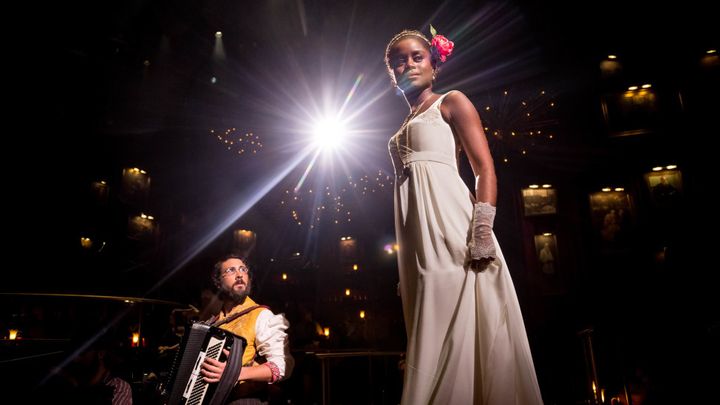
Josh Groban and Denée Benton in The Great Comet
I am proud to team up with the hit Broadway musical, Natasha, Pierre, and & The Great Comet of 1812, which does for War and Peace on stage what I try to do in my book, Give War and Peace a Chance: Tolstoyan Wisdom for Troubled Times and in my keynotes: bring Tolstoy alive for a wide contemporary audience. In this blog series, I share my experience of the show and the ways it captures Tolstoy’s vital relevance for today. The Great Comet, like Tolstoy’s epic, offers not only a rousing, unforgettable story, but also an urgent moral compass and a celebration of the deep joy of living. The musical is wise and funny and profound, but it’s also jaw-droppingly fun entertainment, proving yet again the wisdom of Tolstoy’s words: “Great works of art are only great because they are accessible and comprehensible to everyone.”
Enjoy!
I’ve read War and Peace around 15 times, wrote a book about the novel, and have given talks on the vital relevance of Tolstoy to audiences ranging from college students and incarcerated youth to retired seniors and corporate executives. So it’s particularly exciting for me when an adaptation comes along that allows me to see the book in a fresh light and stirs me to tears over moments I thought I knew by heart. This is what happened when I experienced the hit Broadway musical, Natasha, Pierre, and & The Great Comet of 1812.
And “experience” is the operative word here. From the minute I took my seat at the stylish cocktail table in the Russian salon doubling as center stage, I suddenly realized that I wasn’t just preparing to watch a show. I was in Tolstoy’s novel. Here I’ve just sat down, and Tolstoy’s Anatole Kuragin, who will seduce and then try to run off with young Natasha Rostova, sashays up to me, dressed in the accouterments of a lady-killing fop, his white teeth glistening with a suave smile, and… hands me a fresh-baked Russian pierogi!
How could I possibly hate that maleficent rake after such a simple gesture of hospitality? That moment challenged whatever assumptions I may have had about this literary villain, reminding me yet again that Tolstoy’s living, breathing characters are infinitely complex. At the same time, the musical immediately shattered whatever fourth wall may have existed between the actors, the twelve hundred other theater-goers and me.
“A real work of art,” Tolstoy wrote in his famous essay, “What is Art?”, “destroys . . . the separation between the receiver and the artist, and not that alone, but also between the receiver and all whose minds receive this work of art. In this freeing of our personality from its separation and isolation, in this uniting with others, lies the chief characteristic and the great attractive force of art."
The unification of minds and hearts Tolstoy speaks of us is what we all need more than ever these days. And what better way to give a contemporary audience that much-needed salve than by taking the world’s greatest and most universally human novel — a book that shocked its initial readers by its sheer girth, number of characters, intersecting plot lines, formal oddities, and refusal to follow any of the rules of nice, elegant, European novel-writing — and bringing that to life before our eyes.
I’m convinced that show creator Dave Malloy and director Rachel Chavkin are not pushing the bounds of theater for the sake of creating an artistic revolution on Broadway. Rather, they are striving to bring the fullness of Tolstoy’s vision to a contemporary audience. And when you’re dealing with a book that itself revolutionized world literature, going halfway or tinkering on the edges is just not an option.
Even as it explores new possibilities for musical theater, The Great Comet continually reminds us that we’re experiencing a novel on stage. Characters sometimes speak exact lines from War and Peace or narrate their actions in the third person, as if reciting from the novel. Here is Pierre narrating his final, climactic confrontation with Anatole:
“My face, already pale
Becomes distorted by fury
I seize you by the collar with my big big hands
And I shake you from side to side
Until your face shows a sufficient degree of terror
When I tell you I must talk to you!”
The effect of all this is to call our attention to the artifice behind the magic of the book, not in order to demystify it with a knowing wink-wink but in order to celebrate it, to remind us that we are witnessing before our very eyes one of world literature’s greatest achievements.
Tolstoy said that “the goal of an artist is not to solve a question irrefutably but to force people to love life in all of its countless, inexhaustible manifestations.” In other words, art should never just be about the medium or the message, but about the ongoing quest for truth and the experience of living itself, in all of its rawness and realness and turmoil, all its roiling, overflowing possibility.
The power of The Great Comet isn’t merely in the fact that it willfully re-shapes Tolstoy’s classic according to its own bold conceit, but that it uses the medium of musical theater to bring us surprisingly close to Tolstoy’s original vision. In the blogs to come, I’ll take the reader deeper inside Tolstoy’s novel and the musical it inspired, and discuss how both works of art can help us live fuller, more meaningful lives in our troubled times.
-----